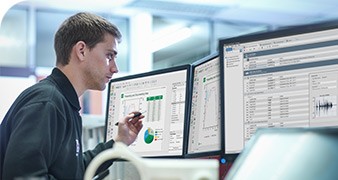Developing Embedded Applications using CompactRIO and LabVIEW FPGA Course Overview
Developing Embedded Applications using CompactRIO and LabVIEW FPGA course delivers a learning experience for designing, prototyping, and deploying reliable FPGA code for your application using NI CompactRIO. At the end of the course, you will be able to translate your embedded system requirements into a scalable software architecture, choose appropriate methods for inter-process communication, design, deploy and replicate your FPGA code for your embedded application.
Available Formats
Course Objectives
-
Design, prototype, and deploy a datalogging control & monitoring application
-
Acquire and generate analog and digital signals, control timing, and implement signal processing on FPGA
-
Implement functionality on the FPGA for maximum performance and reliability using the LabVIEW FPGA Module
-
Implement a human machine interface (HMI) on the PC
-
Communicate data between FPGA, RT, and PC
-
Debug, benchmark, and test your applicationCourse Details
Course Details
Duration
-
Instructor-led Classroom: Three (3) days
-
Instructor-led Virtual: Four (4) days, six-hour sessions
Audience
-
Users preparing to develop embedded control and monitoring applications using LabVIEW Real-Time and LabVIEW FPGA with CompactRIO, Single-Board RIO, and Real-Time PXI hardware
-
Users interested in learning about performance and reliability considerations using NI Real-Time and FPGA targets
Prerequisites
-
LabVIEW Core 1 and LabVIEW Core 2
NI Products Used
-
LabVIEW FPGA Module
-
LabVIEW Real-Time Module
-
CompactRIO Controller
-
C Series analog input, analog output, temperature input, and digital modules
Training Materials
-
Virtual instructor-led training includes digital course material that is delivered through the NI Learning Center
-
NI virtual instructor-led training is delivered through Zoom, and Amazon AppStream/LogMein access is provided to participants to perform the exercises on virtual machines equipped with the latest software
Cost in Credits
-
Public virtual or classroom course: 30 Education Services Credits or 9 Training Credits
-
Private virtual or classroom: 210 Education Services Credits or 60 Training Credits
Developing Embedded Applications using CompactRIO and LabVIEW FPGA Course Outline
| Lesson | Overview | Topics |
|---|---|---|
Programming Using LabVIEW FPGA | Learn about FPGA common usages, how to work with them in LabVIEW, its user interfaces, compilation details and basic optimizations. |
|
Using FPGA I/O and Timing | Explore techniques for accessing and controlling I/O as well as the timing of the FPGA VI. |
|
Signal Processing in LabVIEW FPGA | Explore data types, methods and built-in or external functions to process signals with the FPGA. |
|
Inter-process Communication in LabVIEW FPGA | Explore the available communication mechanisms for processes running in the FPGA |
|
Communicating between the FPGA and Real-Time VIs | Explore the available mechanisms to transfer data between the FPGA and the RT VIs |
|
Exploring Common FPGA Optimizations | Learn about optimizations for the FPGA performance and resource usage. |
|
Debugging and Testing in FPGA | Learn techniques for debugging and testing your FPGA VI and explore some additional resources. |
|
Continue Your Learning Path
Software Engineering for Test Applications
The Software Engineering for Test Applications course focuses on the LabVIEW tools and industry practices for defining, managing, designing, developing, validating, and deploying quality test solutions.
SystemLink Server to Manage Systems and Data
This course teaches how to use the SystemLink server environment to manage test systems, deploy software, manage hardware assets, and collect and analyze test results.
Exploring Data Interactively Using DIAdem
Exploring Data Interactively Using DIAdem teaches importing data sets, analyzing them visually and computationally, and creating publisher-quality reports. Llearn how to use DIAdem SCRIPT to automate each of these tasks.
Upgrade to Membership
If you are planning to take three or more NI instructor-led courses within one year, a Training Membership provides cost-effective, unlimited access to all NI public classroom and public virtual courses, along with unlimited certification vouchers.


